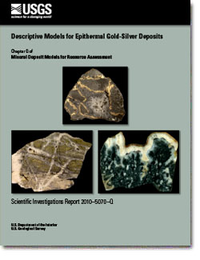Descriptive models for epithermal gold-silver deposits
Links
- Document: Report (40.8 MB pdf)
- Figure: Figure A1 (1.6 MB pdf)
- Appendixes:
- Appendix 1 (55 KB xlsx) Characteristics of epithermal gold-silver deposits
- Appendix 2 (19 KB xlsx) Grade and tonnage data and data sources for epithermal gold deposits
- Appendix 3 (4 MB xlsx) Compilation of isotopic data for epithermal gold-silver mineral deposits
- Download citation as: RIS | Dublin Core
Abstract
Epithermal gold-silver deposits are vein, stockwork, disseminated, and replacement deposits that are mined primarily for their gold and silver contents; some deposits also contain substantial resources of lead, zinc, copper, and (or) mercury. These deposits form in the uppermost parts of the crust, at depths less than about 1,500 meters below the water table, and at temperatures below about 300 °C. Most epithermal gold-silver deposits are genetically related to hydrothermal systems associated with subaerial volcanism and intrusion of calc-alkaline magmas along convergent plate margins. These deposits formed throughout most of geologic time, although most known deposits are Cenozoic, which reflects preferential preservation of these shallowly formed deposits in tectonically unstable regions. Epithermal gold-silver deposits range in size from tens of thousands to greater than 1 billion metric tons of ore and have gold contents of 0.1 to greater than 30 grams per metric ton and silver contents of less than 1 to several thousand grams per metric ton. Historically, these deposits have been an important source of gold and silver and are estimated to contain about 8 percent of global gold. The wide range of tonnage-grade characteristics makes epithermal gold-silver deposits an attractive target for small and large exploration and mining companies.
This report constitutes a new descriptive model for epithermal gold-silver deposits. It summarizes characteristics of known deposits, including their geological, geophysical, geochemical, and geoenvironmental aspects. Models concerning the genesis of epithermal gold-silver deposits are discussed. The application of descriptive and genetic aspects of the model to mineral exploration and resource assessment of undiscovered deposits is described. Finally, areas where additional research is needed to better understand the genesis of these deposits are identified. An extensive summary table outlining the characteristics of about 100 epithermal gold-silver deposits is included as an appendix; this summary table includes most of the world’s largest epithermal gold-silver deposits, and many smaller, well-studied deposits.
Suggested Citation
John, D.A., Vikre, P.G., du Bray, E.A., Blakely, R.J., Fey, D.L., Rockwell, B.W., Mauk, J.L., Anderson, E.D., and Graybeal, F.T., 2018, Descriptive models for epithermal gold-silver deposits: U.S. Geological Survey Scientific Investigations Report 2010–5070–Q, 247 p., https://doi.org/10.3133/sir20105070Q.
ISSN: 2328-0328 (online)
Table of Contents
- Abstract
- Chapter A. Introduction
- Chapter B. Definition and Classification of Epithermal Gold-Silver Deposits
- Chapter C. Deposit Type and Associated Commodities
- Chapter D. History of Epithermal Gold-Silver Deposits
- Chapter E. Regional Environment
- Chapter F. Physical Description of Deposits
- Chapter G. Geophysical Characteristics
- Chapter H. Spectral Remote Sensing of Epithermal Mineral Deposits
- Chapter I. Hypogene and Supergene Ore Characteristics
- Chapter J. Hypogene and Supergene Gangue Characteristics
- Chapter K. Geochemical Characteristics
- Chapter L. Hydrothermal Alteration
- Chapter M. Petrology of Associated Igneous Rocks
- Chapter N. Petrology of Associated Sedimentary Rocks
- Chapter O. Petrology of Associated Metamorphic Rocks
- Chapter P. Theory of Deposit Formation
- Chapter Q. Weathering and Supergene Processes
- Chapter R. Geoenvironmental Features
- Chapter S. Exploration and Assessment Techniques
- Chapter T. Research Directions
- Acknowledgments.
- References Cited
- Appendixes 1–3
| Publication type | Report |
|---|---|
| Publication Subtype | USGS Numbered Series |
| Title | Descriptive models for epithermal gold-silver deposits |
| Series title | Scientific Investigations Report |
| Series number | 2010-5070 |
| Chapter | Q |
| DOI | 10.3133/sir20105070Q |
| Publication Date | November 07, 2018 |
| Year Published | 2018 |
| Language | English |
| Publisher | U.S. Geological Survey |
| Publisher location | Reston, VA |
| Contributing office(s) | Central Energy Resources Science Center, Central Mineral and Environmental Resources Science Center, Geology, Minerals, Energy, and Geophysics Science Center, Western Fisheries Research Center |
| Description | Report: xi, 246 p.; 1 Figure; 3 Appendixes |
| Larger Work Type | Report |
| Larger Work Subtype | USGS Numbered Series |
| Larger Work Title | Mineral deposit models for resource assessment (Investigations Report 2010–5070) |
| Online Only (Y/N) | Y |
| Additional Online Files (Y/N) | Y |


